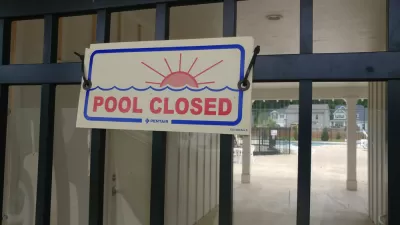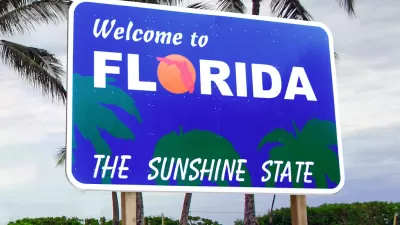Younger people are making up more of the new cases of COVID-19 as the coronavirus explodes in the Sunbelt states, particularly Arizona, California, Florida, and Texas, bringing with it new attention on bars as settings for high viral transmission.

"Younger people are making up a growing percentage of new coronavirus cases in cities and states where the virus is now surging, a trend that has alarmed public health officials and prompted renewed pleas for masks and social distancing," report Julie Bosman and Sarah Mervosh for The New York Times on June 25.
In Arizona, where drive-up sites are overwhelmed by people seeking coronavirus tests, people ages 20 to 44 account for nearly half of all cases. In Florida, which breaks records for new cases nearly every day, the median age of residents testing positive for the virus has dropped to 35, down from 65 in March.
In Texas, where Gov. Gregg Abbott hit the pause button on the reopening plan Thursday and closed bars on Friday, "young people now account for the majority of new cases in several urban centers," add Bosman and Mervosh.
“What is clear is that the proportion of people who are younger appears to have dramatically changed,” said Joseph McCormick, a professor of epidemiology at UTHealth School of Public Health in Brownsville. “It’s really quite disturbing.”
At the first press conference held by the White House Coronavirus Task Force in nearly two months on Friday, Vice President Mike Pence stated that "[h]alf of the new COVID-19 cases detected in recent weeks have been in adults under 35," reported Stephanie Soucheray for CIDRAP News.
The press briefing was held as America saw another record COVID-19 day, with more than 41,000 cases reported in the past 24 hours, and Florida tracking nearly 9,000 new cases.
In total the United States has 2,446,706 COVID-19 cases and 124,749 deaths, according to the tracker maintained by Johns Hopkins University.
"The new cases among young people may appear to be a departure from the early days of the pandemic when infections in nursing homes were spiraling out of control, and the virus appeared at higher rates among older people in New York City," add Bosman and Mervosh.
Focus on bars and alcohol
Along with the younger demographic comes a new focus on bars, a "congregate setting" as noted by Former Food and Drug Administration commissioner Scott Gottlieb in a related post.
"If I could go back and redo anything, it probably would have been to slow down the opening of bars, now seeing in the aftermath of how quickly the coronavirus spread in the bar setting," Gov. Gregg Abbott of Texas said during an evening interview with KVIA in El Paso, reported Patrick Svitek for The Texas Tribune on June 26.
Abbott added that the "bar setting, in reality, just doesn't work with a pandemic," noting people "go to bars to get close and to drink and to socialize, and that's the kind of thing that stokes the spread of the coronavirus."
"Florida banned serving alcohol at bars Friday, effectively shutting them down on the same day that the state reported a record-shattering number of new coronavirus cases," reported the Orlando Sentinel.
California dials back
On Sunday, Gov. Gavin Newsom came to that same realization in dealing with outbreaks in California, reports Jessica Yadegaran for the Bay Area News Group on June 28. Unlike his counterparts in Florida and Texas, his order was targeted to specific counties.
Bars in Fresno, Imperial, Kern, Kings, Los Angeles, San Joaquin and Tulare counties were ordered to close because they have been on the COVID-19 watch list for two weeks. Counties on the recommended list [to close bars] — including Riverside, Sacramento, San Bernardino, Santa Barbara, Stanislaus and Ventura — have been on the watch list for at least three days.
Sunday’s escalation provided the most urgent call yet to the state’s residents, a warning that scenes of bars and nightclubs packed with young people belied the strength of the virus and its danger to public health.
While the effect of the coronavirus on younger people “may not be highly associated with hospitalization and death,” Dr. Robert Redfield, Director of the Centers for Disease Control and Prevention said at Friday's task force news conference held at the Department of Health and Humans Services, "they do act as a transmission connector for individuals that could in fact be at a higher risk."
While mostly observed in the U.S., the trend has been observed in Israel and Portugal as they reopen, and is being monitored by the World Health Organization, reports Peter Beaumont for The Guardian on June 26.
Related in Planetizen:
- Texas Hits Pause as Hospital Beds Fill Up, June 26, 2020
- [Bars and nightclubs close in Boise, Idaho], June 24, 2020
FULL STORY: As Virus Surges, Younger People Account for ‘Disturbing’ Number of Cases

Trump Administration Could Effectively End Housing Voucher Program
Federal officials are eyeing major cuts to the Section 8 program that helps millions of low-income households pay rent.

Planetizen Federal Action Tracker
A weekly monitor of how Trump’s orders and actions are impacting planners and planning in America.

Ken Jennings Launches Transit Web Series
The Jeopardy champ wants you to ride public transit.

New Mexico Aging Department Commits to Helping Seniors Age ‘In Place’ and ‘Autonomously’ in New Draft Plan
As New Mexico’s population of seniors continues to grow, the state’s aging department is proposing expanded initiatives to help seniors maintain their autonomy while also supporting family caregivers.

USDOT Waters Down Self-Driving Car Regulations
The agency is reducing reporting requirements for autonomous vehicles and cars with self-driving features, prompting concern among safety advocates who say transparency is essential to the safe deployment of AV technology.

‘Minnesota Nice’ Isn’t so Nice When You Can’t Find a Place to Live
The Economic Development and Housing Challenge Program can help address the scourge of homelessness among Indigenous people.
Urban Design for Planners 1: Software Tools
This six-course series explores essential urban design concepts using open source software and equips planners with the tools they need to participate fully in the urban design process.
Planning for Universal Design
Learn the tools for implementing Universal Design in planning regulations.
Heyer Gruel & Associates PA
Ada County Highway District
Institute for Housing and Urban Development Studies (IHS)
City of Grandview
Harvard GSD Executive Education
Toledo-Lucas County Plan Commissions
Salt Lake City
NYU Wagner Graduate School of Public Service





























